Situated just off the western slope of the Athens Acropolis, a small rocky outcrop of solid marble rock rises to a height of 115 metres. From its peak, the monumental Propylaia marking the entryway to the Acropolis hilltop can be seen clearly, while the crowning glory of the Acropolis – the Parthenon, is just out of sight from the viewer’s vantage point.
The small size of this rocky outcrop belies its historical significance. This is the Areopagus Hill, the ancient site of the Areopagus (Άρειος Πάγος). Literally translated as the “Hill of Ares”, the name “Areopagus” itself would come to refer to more than just the Hill.
I go into a rather long historical background about the Areopagus in "What was the Areopagus". If you just want to read about my visit, feel free to skip it.
Where is the Areopagus Hill?
The Areopagus Hill is located on Theorias street just off the west slope of the Acropolis. If you’re exiting the Acropolis through the Propylaia and down the western path, the Areopagus Hill is located right at the end of the path. All you have to do is follow the path down.
If you’re coming down Dionysiou Areopagitou street from Hadrian’s Arch, you’ll have to walk to the end of the street and then turn right up the path.
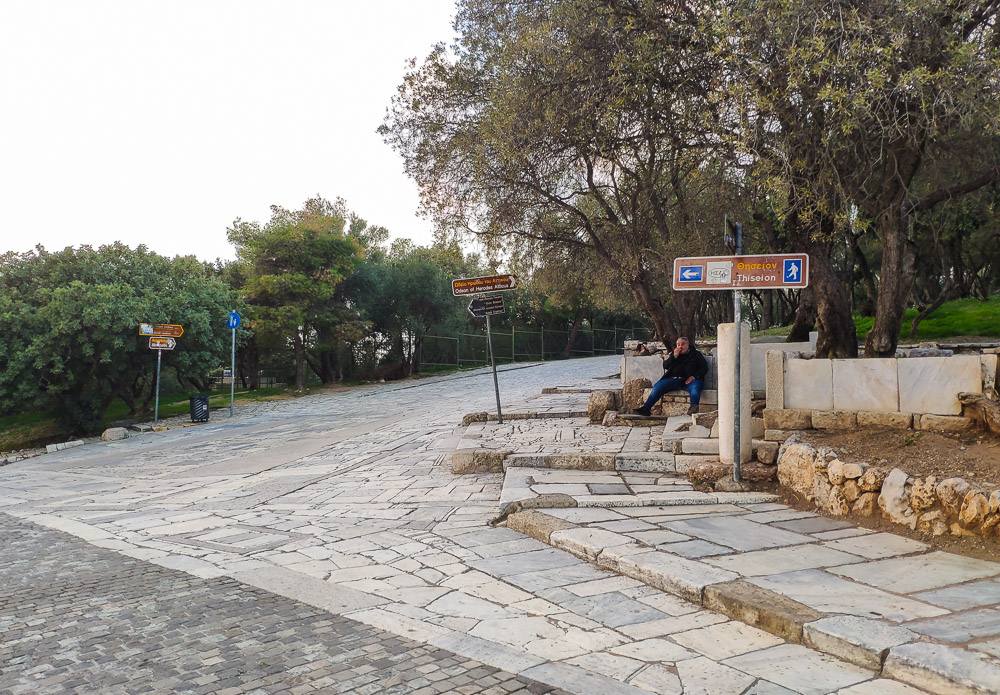


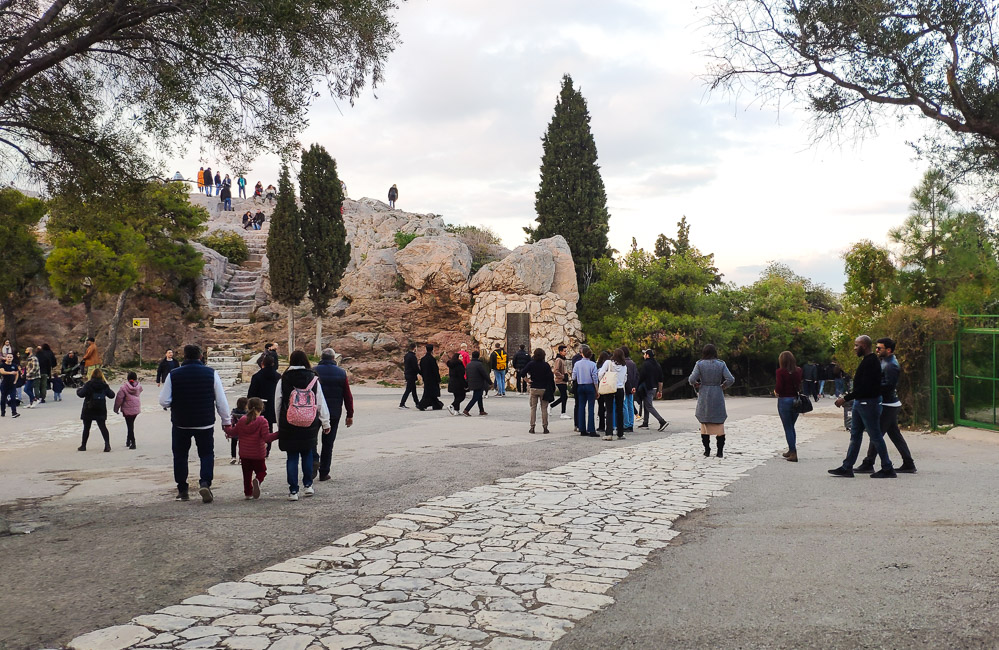
The Hill is quite hard to miss as it’s usually swarming with tourists. If in doubt, look for the big rocky thing with tourists standing on top.
Google Maps Link: https://goo.gl/maps/SkdN9fBtGBV4S85SA
Visiting the Areopagus Hill
The Hill is accessed via modern steel stairs. Visitors used to have to climb up an older flight of stairs cut into the rock itself, but it was roped off when I visited.

There is only one set of stairs heading up and down the Hill, so the stairs can get crowded at times.
The top of the Hill gives great views across the western areas of Athens. From this vantage point, you are in a great position to look down on the adjacent Ancient Agora site, with the Temple of Hephaestus and Stoa of Attalos particularly prominent among the ruins. Turn to the southwest and you get a great view of the National Observatory of Athens, the Pnyx, and the Philopappos Monument in the near distance.


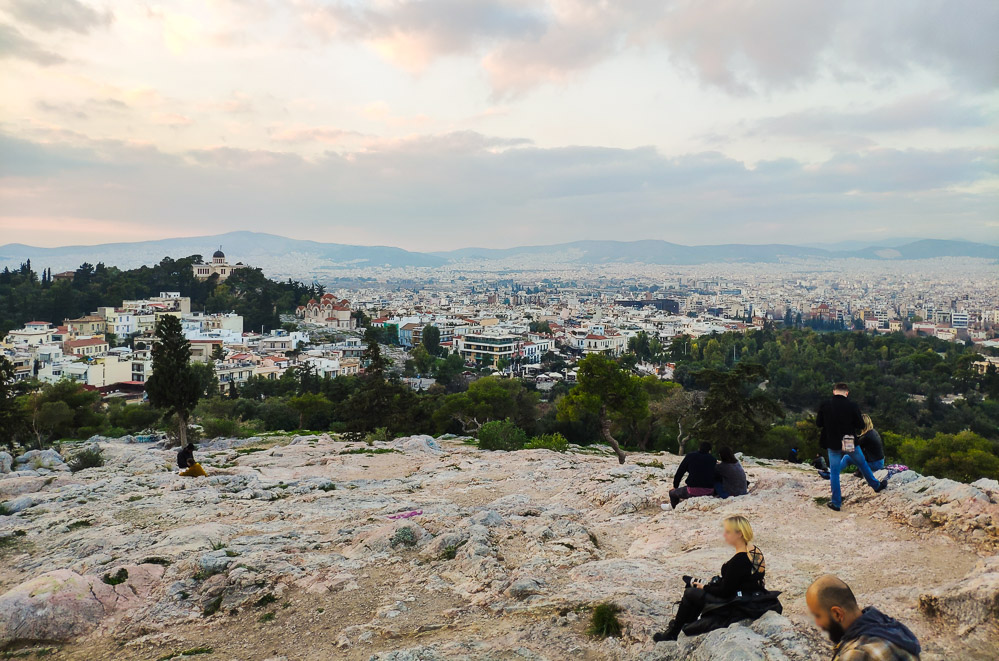
The eastern side of the Hill is the most popular with visitors as it gives a great view of the monumental Propylaia on the Acropolis hilltop.


The surface at the top is rocky and jagged. A concrete path was laid around the back of the hilltop, but it stops abruptly and does not continue around the site. The rocky surface is also slippery as a result of centuries of wear, and it is easy to slip and fall if you’re not careful.
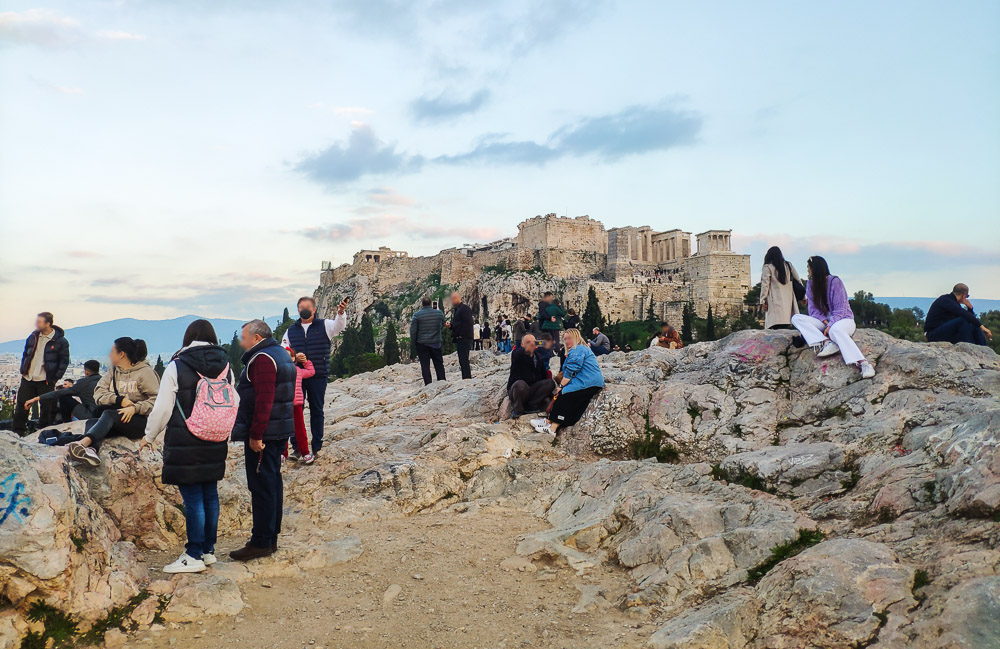
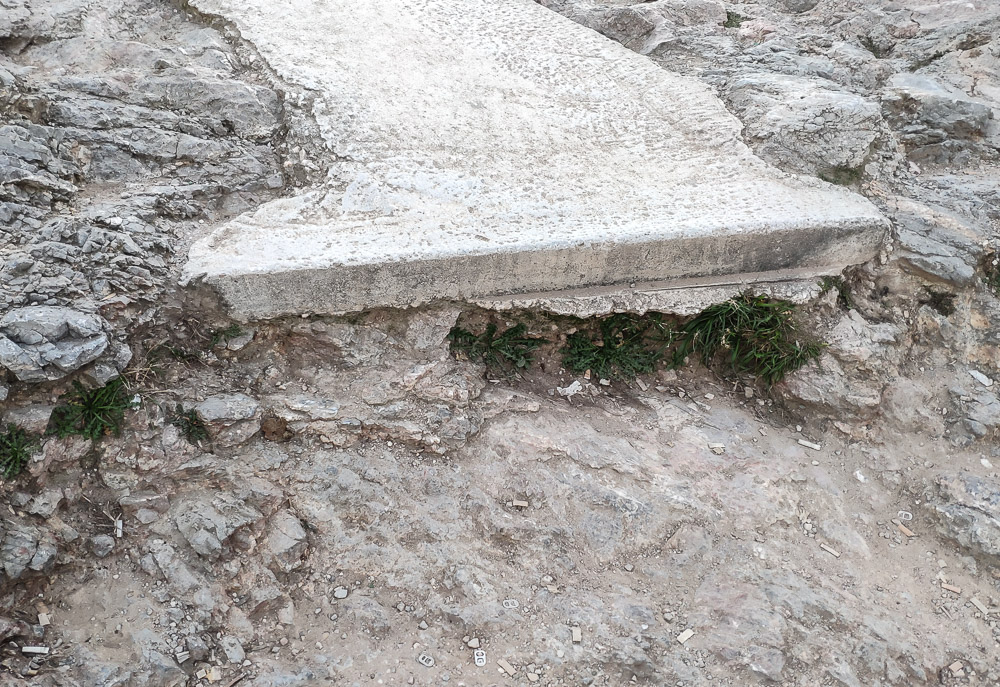
It goes without saying that the Hill is not accessible for the disabled. You should also take care not to go over the edge of the Hill as there are no barriers at the edge.
I visited the Hill twice – at noon and in the evening. The atmosphere in the evening was more relaxed, and the late December wind kept everyone cool. While the Hill was packed with visitors, everyone was enjoying the view and wasn’t really in a rush to go anywhere. This was a small world removed from the hustle and bustle of modern Athens below, and from the crowd of tourists heading out of the Acropolis. Interestingly, some visitors chose to catch up on their reading at the top – I spotted some avid readers perched comfortably on some of the rocky ledges around the dips in the hilltop surface.
The Hill could be a great place to catch the sunset if the sun is working in your favour that day. But it gets packed with people fast, and unless you have a lot of patience, you shouldn’t expect to be able to do serious photography here. The hilltop is also not lit, and gets extra tricky to navigate after dark.
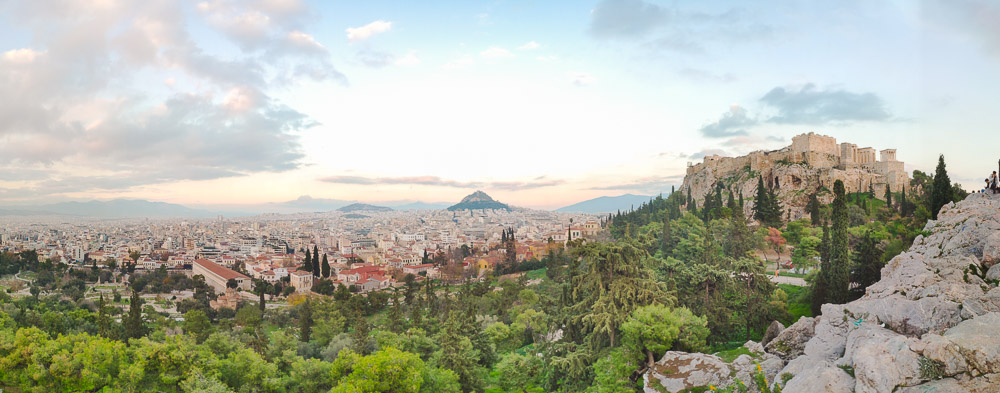
I wasn’t so lucky that day, but I was glad I visited in the evening nonetheless. It was a nice way to take in Athens from above before exploring the city properly, almost like a certain misthios with a certain eagle on a certain Odyssey…
Opening Hours and Tickets
The Areopagus Hill is free to visit!
The Hill is also open 24 hours a day, which means you don’t have to rush to fit the Hill in before a closing hour.
What was the Areopagus?
The early history of the Areopagus isn’t clear, but it is thought that the hilltop was the seat of the aristocratic governing council of archaic Athens before the 5th century BC, sort of like a council of elders. Membership of this governing council was limited only to citizens who had held high public office previously – in this case that of Archon (Άρχων).
The council eventually came to be associated with the name of its primary meeting place – the Areopagus Hill. The term “Areopagus” would later come to mean the council itself, regardless of where the council actually met.
After the democratic reforms instituted circa the 5th century BC by Solon, an Archon of archaic Athens in the role of Chief Magistrate, the Areopagus evolved into a judicial council for the ancient city. In this role, the Areopagus acquired a stellar reputation for the quality of its investigations and judgments.
Take the example of the Senate of the Areopagus, the most scrupulous tribunal in the city. I myself have before now seen many men convicted before this tribunal, though they spoke most eloquently, and presented witnesses; and I know that before now certain men have won their case, although they spoke most feebly, and although no witnesses testified for them. For it is not on the strength of the pleading alone, nor of the testimony alone, that the members of the court give their verdict, but on the strength of their own knowledge and their own investigations. And this is the reason why that tribunal maintains its high repute in the city.
Aeschines, Against Timarchus, 1.92
In the 4th century BC, the Areopagus assumed its principal competence over serious crimes, particularly cases of intentional homicide. Among other cases of serious crimes that fell under the council’s competence were assault, wounding, and cases of sacrilege including acts of cutting down the sacred olive trees of the Attica region. The reputation of the Areopagus also survived untarnished, as it continued to be renowned for its well founded decisions.
If you're reading this and happen to be trained in the Anglo-American common law tradition, just remember that the judges of the Areopagus were also empowered with investigative functions.
While the ancient Areopagus later ceased operations as a council around the 5th century AD, the name “Areopagus” was resurrected in Greek officialdom on 16 October 1834 as the official name of the Supreme Civil and Criminal Court of Greece (Άρειος Πάγος) – the supreme court of Greece for Civil and Criminal Law.
For the source of the information above and more in-depth reading, please visit "The Council of the Areopagus", a publication by Christopher W. Blackwell on Dēmos here.
Final Thoughts
The small size of the Areopagus Hill and its position next to the Acropolis may make it easy to overlook. But if you have an appreciation for legal history and the institutional history of ancient Athens, the historical significance of the Hill makes it a must-visit.
Besides, its free and always open. What’s not to love?
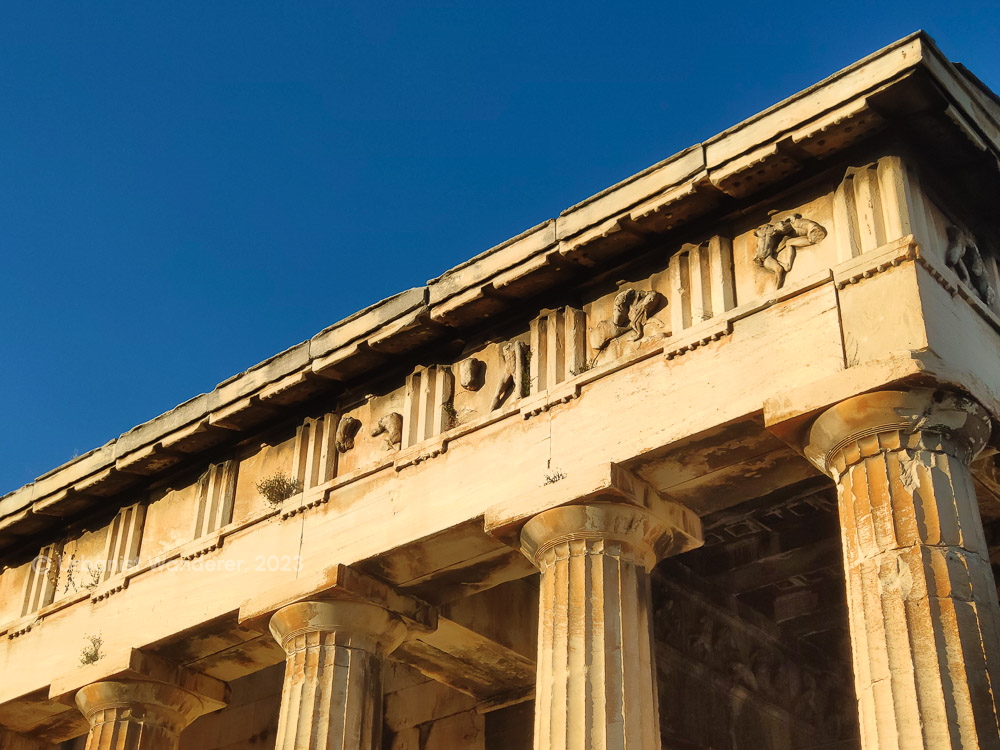

Comments
2 responses to “Athens in Winter | The Areopagus Hill”
[…] Access is as simple as walking straight down the street, past the turn off to the Areopagus, and crossing Rovertou Galli street (Οδός Ροβέρτου Γκάλι). Be careful when […]
[…] The area just before the ticket gates is also where you will find the Areopagus – Entrance is free and it’s open 24/7. […]